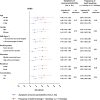Prevalence, General and Periodontal Risk Factors of Gastroesophageal Reflux Disease in China
- PMID: 36691403
- PMCID: PMC9863457
- DOI: 10.2147/JIR.S395777
Prevalence, General and Periodontal Risk Factors of Gastroesophageal Reflux Disease in China
Abstract
Purpose: There is insufficient information about the prevalence and risk factors of gastroesophageal reflux disease (GERD) in the Chinese adult population. We aimed to assess the prevalence and identify the risk factors of GERD in China.
Methods: We collected data from a nationally representative sample (50,991 subjects) of Chinese adults from a large nation-wide cross-sectional survey. GERD was diagnosed by a standardized Chinese-language GERD questionnaire with a score of ≥ 8. The demographic characteristics, comorbidities and periodontal factors of all participants were collected.
Results: Fifty-thousands-one-hundred-eighty-three participants were finally included in this study. The overall prevalence of GERD was 5.6% (95% CI, 5.4-5.8%) among the general Chinese population aged 20 years or older. Women, smokers, and people with older age, BMI ≥ 25.0 kg/m2, urban residence, lower education level or comorbidities were more prevalent with GERD (p < 0.001). Symptoms of severe periodontitis (OR = 1.40, 95% CI 1.28-1.52, p < 0.001) and lower frequency of tooth brushing (OR = 2.01, 95% CI 1.76-2.29, p < 0.001) were significantly associated with risk of GERD.
Conclusion: Symptom-based GERD is highly prevalent in the Chinese population. Overweight and smoking are major preventable risk factors for GERD. Periodontal factors are novel potential risk factors for GERD and should be given more attention in GERD prevention.
Keywords: epidemiology; gastroesophageal reflux disease; periodontitis; prevalence; risk factor.
© 2023 Liu et al.
Conflict of interest statement
The authors declare that they have no conflicts of interest in this work.
Figures




References
LinkOut - more resources
Full Text Sources

